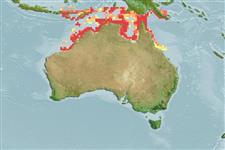Teleostei (teleosts) >
Eupercaria/misc (Various families in series Eupercaria) >
Labridae (Wrasses) > Bodianinae
Etymology: Choerodon: Greek, choiros = a pig + odous = teeth (Ref. 45335); referrring to the prominent anterior canines of the species in this genus (Ref. 116605).
More on author: Ogilby.
Environment: milieu / climate zone / depth range / distribution range
Ecology
Marine; demersal; depth range 10 - 40 m (Ref. 90102). Tropical
Western Central Pacific: northwestern Australia (Ref. 3131) and Papua New Guinea (Ref. 6192).
Size / Weight / Age
Maturity: Lm ? range ? - ? cm
Max length : 25.0 cm TL male/unsexed; (Ref. 3132)
Dorsal spines (total): 13; Dorsal soft rays (total): 7; Anal spines: 3; Anal soft rays: 10. Body mostly pale with faint broad dusky bands especially dorsally. A prominent ocellated dark spot present on dorsal fin between last few spines. Body deep at level of dorsal-fin origin (2.3 to 2.6 times in SL). Second prominent anterior canine mostly straight, only slightly curved in large specimens, angled dorsolaterally and sometimes slightly posteriorly.
Adults inhabit flat sandy or weedy areas (Ref. 3131). Found solitary in rubble, silt or sand bottoms (Ref. 90102). Oviparous, distinct pairing during breeding (Ref. 205). A good food fish.
Life cycle and mating behavior
Maturities | Reproduction | Spawnings | Egg(s) | Fecundities | Larvae
Oviparous, distinct pairing during breeding (Ref. 205).
Sainsbury, K.J., P.J. Kailola and G.G. Leyland, 1985. Continental shelf fishes of the northern and north-western Australia. An illustrated guide. CSIRO Division of Fisheries Research; Clouston & Hall and Peter Pownall Fisheries Information Service, Canberra, Australia. 375 p. (Ref. 3131)
IUCN Red List Status (Ref. 130435)
Threat to humans
Harmless
Human uses
Tools
Special reports
Download XML
Internet sources
Estimates based on models
Preferred temperature (Ref.
123201): 24.7 - 28.8, mean 27.7 °C (based on 228 cells).
Phylogenetic diversity index (Ref.
82804): PD
50 = 0.5000 [Uniqueness, from 0.5 = low to 2.0 = high].
Bayesian length-weight: a=0.01318 (0.00582 - 0.02984), b=3.05 (2.86 - 3.24), in cm total length, based on LWR estimates for this (Sub)family-body shape (Ref.
93245).
Trophic level (Ref.
69278): 3.4 ±0.4 se; based on size and trophs of closest relatives
Resilience (Ref.
120179): Medium, minimum population doubling time 1.4 - 4.4 years (Preliminary K or Fecundity.).
Fishing Vulnerability (Ref.
59153): Low vulnerability (15 of 100).
Nutrients (Ref.
124155): Calcium = 174 [90, 339] mg/100g; Iron = 1.15 [0.62, 2.29] mg/100g; Protein = 18.1 [15.3, 20.2] %; Omega3 = 0.264 [0.153, 0.463] g/100g; Selenium = 39.3 [20.4, 81.1] μg/100g; VitaminA = 37.5 [10.4, 146.9] μg/100g; Zinc = 1.24 [0.86, 2.04] mg/100g (wet weight);
